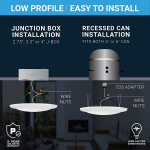Give me a break. Most light fixtures are "mounted" to the junction box and not to the ceiling. However they are still surface mounted in relation to the ceiling. My wording could have been better. The back of this light fixture (it is not trim it is a light fixture) is resting on the ceiling. It is not a recessed light fixture. They are merely using the exiting can light as a junction box.
EDIT: The only difference in the junction box mount vs the can light mount is that it is using clips of a sort instead of screws to secure it.
I agree it's not recessed.
It's also not surface mounted.
But those are the only options we're given.
A fluorescent strip light or wraparound are surface mount. They actually attach to the ceiling itself. And none of it is inside the ceiling. No connections are inside the ceiling.
I think there's a very clear way to define/describe surface mounting, and these are not.
The only reason I'm being so technical about it is to highlight how the NEC really has us in a bind on this one.
A very practical solution in the eyes of most, but along comes AHJ and sees the NEC only mentions recessed versus surface mounting, and he can see it's clearly not recessed. So what's he supposed to do?
As others have mentioned before, I think at a minimum the wording needs to be clarified or added to

